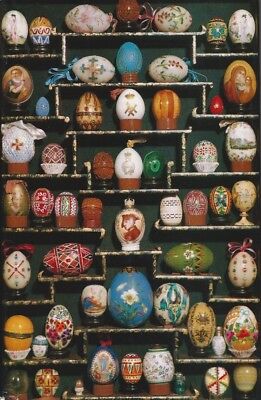The World of Books
by the Books Editor
This year we are celebrating Easter in a time of trial. With so many of us being isolated, or rather ‘cocooned’ we have to celebrate much as the very early Christians did, just within the family circle – and indeed as Jews today still celebrate the Passover.
In the ‘old days’, by which I mean the 1950s, in our family circle it was the custom to paint eggs for eating on Easter morning. From my father’s drawing office an array of brightly-coloured drawing inks used for marking up his engineering plans would be brought up. This gaily assorted array was just the thing to catch the eye of small children. Decorating the eggs was an around-the-kitchen table activity.
It struck me that this year, with so many of us not going out, we could do nothing better than to revive the custom.
Commercialised chocolate eggs are only a late-Victorian creation of commerce. On the other hand, painted eggs are an age old tradition, so old indeed that controversy over their origin and meaning happily engages the minds of countless scholars.
The best book by far about this whole topic is Venetia Newall’s An Egg at Easter (London, 1971). Taking down my copy of this classic I was surprised to be reminded that the front of the jacket was a panel that simply showed an array of decorated eggs covering several centuries. A well-travelled journalist, she was President of the Folklore Society in 1984-87.
Her long, delightful book traces the use of eggs in tradition, religion and custom over many centuries, all over the world. But at this time of the year of especial interest is a chapter devoted to ‘Christian eggs’.
She tells us too that art critics who have made a study of medieval symbolism showed that the egg often represented the Immaculate Conception”
Here one reads that Henry VIII, while still a Catholic, received from the Pope an Easter egg enclosed in a silver case. But elsewhere ostrich eggs, which are exceptionally large, were thought fit to hold the relics of SS Benoit, Thierry, Aman, Crespin and Crespinianin. St Rupertus, Bishop of Salzburg, who died in 718, has a basket of eggs as his symbol.
She tells us too that art critics who have made a study of medieval symbolism showed that the egg often represented the Immaculate Conception. Painters like Bosch and the theologians like Albertus Magus refer to this symbolism.
The symbolic egg “lay at the very heart of Easter Story”. The 16th-Century Codex Sandor “makes the comparison more direct: the white of the egg is Christ’s pure soul, the gold yolk his godliness”.
Maundy Thursday on the eve of Good Friday was not a suitable time for celebration. So in Spain and other countries, the feast of Corpus Christi, she notes “has a close link with Easter, for it commemorates the institution of the Eucharist, an essentially joyful event, which cannot be suitably celebrated on Maundy Thursday”.
She concluded this particular chapter by noting: “When the egg can so closely be taken as a symbol of the Eucharist, it is logical enough that it was once the Christian duty of Catholics to eat one at Easter time.”
Much of this long European tradition and its customs have been overwhelmed by the commercialism of the modern American ‘Easter bunny’ nonsense. This seems to have been brought into that country not from these islands, but from Germany, and to have perhaps a more direct pagan that traditional Christian origin.
In any case, as eggs were often not eaten in Lent – the last of them having been used up in making the pancakes on Shrove Tuesday, Easter Sunday morning was the first time that they could be happily eaten again.
Certainly in our house we boiled and opened and ate the painted Easter eggs.
But as from those that were eaten others would be created for the sheer pleasure of doing something creative and to recall in a small way some of the ancient and early Christian ideas about eggs.
Of course, if an egg is to be decorated to keep it will have to be blown, as egg collectors used to blow their specimens. This is simple – a straw or glass tube is used to blow air into the egg through a small hole, through which the fluid contents are expelled.


 Peter Costello
Peter Costello 'An Egg at Easter', Newall, 1971 - book cover
'An Egg at Easter', Newall, 1971 - book cover 